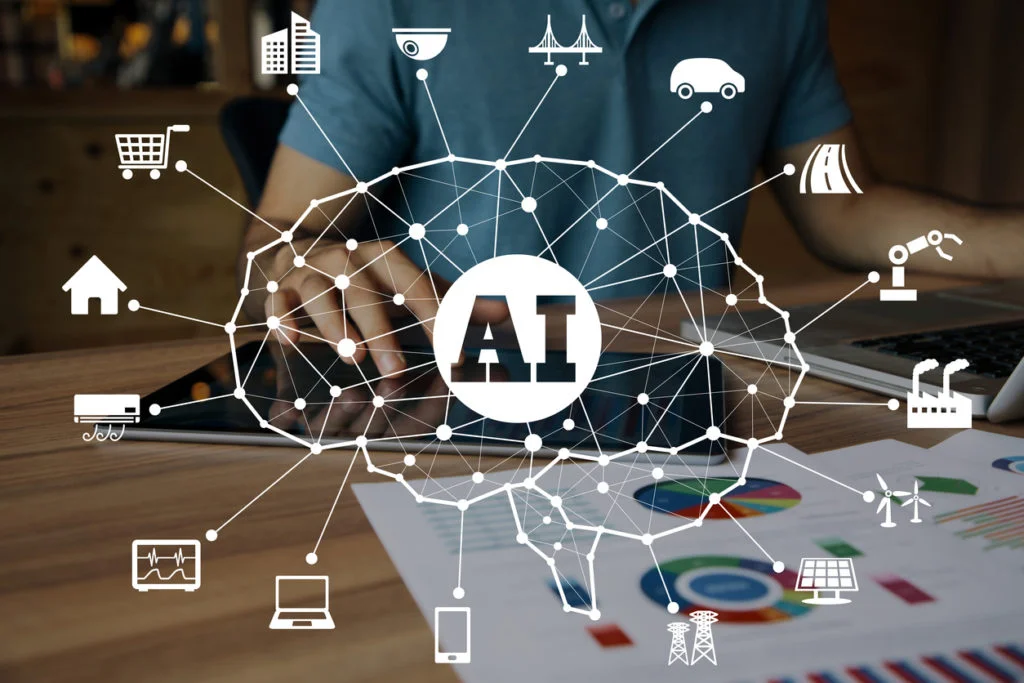The United Nations (UN) estimates that the global population will reach 9.8 billion people in 2050. 70% of this population will be urban. With this increased growth, things are going to get trickier for governments and municipalities. In many cities of the world, the existing infrastructure is not adequate for meeting the needs of an entire urban population.
With the urban population expected to grow in the next few years, the issue could really get out of hand. Something needs to be done and fast to accommodate this growing urban population. The concept of smart cities offers a potential solution.
Today, more and more municipalities in different parts of the world are turning to the smart cities concept to improve infrastructure, communication, and services for residents. They have accepted the challenge of improving their cities to accommodate a growing population. This is because they have technology such as Artificial Intelligence (AI) available to them for this purpose.
To realize the concept of smart cities, municipalities need an underlying infrastructure of dependable network connections. Fueled by the internet of things (IoT) and artificial intelligence (AI), the network will ensure streamlined communication across the city.
The combination of IoT and AI can provide intelligent insights that cities need to minimize strain on existing infrastructure, prevent deterioration of the environment, minimize traffic congestion, thwart urban crime, and improve sanitation. Put simply, with IoT and AI, there is a potential to make city life more comfortable and secure for residents no matter how much the population grows. Following is a detailed look at the smart city concept and how artificial intelligence (AI) is helping to unlock it.
The Smart City Concept and How AI is Helping to Unlock It
Smart city is a concept used to describe an urban area that leverages technology and intelligent insights from sensors to make life more comfortable and secure for residents. While several technologies are used to realize the concept, there are two key enablers of the smart city: internet of things (IoT) and artificial intelligence (AI).
IoT allows cities to gain intelligent insights from connected devices or sensors. With these insights, cities can reduce pollution levels, minimize traffic congestions, or drive the success of city initiatives. Artificial intelligence, on the other hand, makes use of smart algorithms to help automate and improve many activities and operations of a municipality.
Commitment towards using IoT and AI to improve cities and unlock opportunities will pave the way for a better future for municipalities across the planet. With this commitment, cities can inch closer to the future of smart cities where everything from parking, waste management, traffic management, public safety, water and power management, and citizen engagement is ‘smart’ and efficient. Considering this, it should not come as a surprise that cities invested $80 billion in smart technologies in 2018. By 2021, this number is expected to increase to $135 billion. Clearly, technologies such as IoT and AI are the key to realizing the smart city concept.
From improving living conditions for residents to enabling cities to be more competitive, artificial intelligence (AI) is playing a key role in making the smart city concept a reality. Following are some of the ways AI, in combination with IoT, is helping to unlock the smart city concept.
1. Livability
A major characteristic or quality of a smart city is livability. A city with high ‘livability’ would be one with healthy living conditions; little pollution,less congestion, and instant access to services. All this is enabled by a ‘smart’ city infrastructure. While various technologies make up this infrastructure, they share the same goals of improving living conditions and making cities more sustainable and competitive.
Truth be told, urban planners have been working towards these for as long as cities have existed. The only difference now is that they are using technology for the purpose. For example, the idea of widening streets to minimize congestion have existed for centuries. The only change now is that we are using machinery and intelligent technology instead of manual labor and human ingenuity. This is making it easier for cities to achieve their goal of improved living conditions and more sustainable and competitive cities.
A technology that is aiding their mission is artificial intelligence (AI). AI equips machines and computers with the ability to see, listen, move, and think. For example, computer vision systems powered by AI can make it possible for computers to detect many elements of urban lifesuch as cars, humans, accidents, trash, disasters, fires etc. at the same time.
AI not only enables autonomous monitoring, but it also allows decision making based on how the various elements of urban life behave, change over time, and respond to the city system. To put it simply, artificial intelligence (AI) can assist urban planner to plan better for their cities. It can do this by allowing planners to know how cities are being used and how they are functioning.
This quality of AI is already encouraging many city planners to use AI to minimize traffic congestion and parking management. In the future, AI could be used for even more factors that affect livability in a city.
2. Workability
Another aspect of cities that can be improved with the use of artificial intelligence (AI) is workability. This is the infrastructure enabled to allow the city to compete on a global scale for work and jobs. Think computing, connectivity, energy, and other essential services.
A real-life example of improving workability in cities with AI is WienBot. Enabled by AI technology, Wienbot is a chatbot that Vienna’s government uses to deliver personalized digital services to customers. The widespread provision of personalized digital services is a major step towards improving the workability of a city and realizing the smart city concept.
3. Sustainability
One of the most important qualities of a smart city is that it does not ‘steal’ from future generations.Contrary to what environmentalist and other critics say, urbanization is not all bad. In fact, many benefits can be yielded from these urban initiatives. These include, but are not limited to, improved educational opportunities, better healthcare, and improved infrastructure and services.
The problem arises when these initiatives are started without accounting for their future impact. This includes both their environmental and societal impact. Urban initiatives that are started without consideration of their future impact typically lead to unsustainable settlements. These are settlements where it becomes difficult, if not impossible, for the population to make social, personal, or economic advancement. The good news is that innovative technologies such as artificial intelligence can help to address the problem.
AI can make inadequate or counter-productive urban planning a thing of the past. By providing intelligent insights, AI can allow city planners to allocate resources more efficiently, use existing assets more effectively, and improve the sharing and management of data and information across systems. According to the McKinsey Global Institute, technology such as AI can help to lower emissions by up to 15%, minimize water consumption by up to 30% and reduce the average time to commute by up to20%.
This refers to equal access to quality learning opportunities across an organized system that spans a person’s lifetime. The concept of the smart city emphasizes broadening the learning environment from schools to a whole city. In a smart city, typical learning environments include family, school, workplace, and even public places such as museums. AI can be an enabler for this aspect of the smart city because the artificial intelligence (AI) code can support every feature of life. This includes the learning environments that make up a smart city.
The AI Use Cases for Smart Cities
What is that makes a city ‘smart’? The most common perception is that it refers to the use of intelligent or smart technology such as cloud infrastructure, advanced data analytics, and sensors to improve infrastructure and services within a city.
While any technological revolution can misfire at some point, there is little doubt that smart technology is helping to improve the infrastructure and services within a city. A technology that is helping accelerate the realization of the smart city concept is artificial intelligence (AI). Following are some of the ways AI is helping to realize the smart city concept.
1. Smart Parking
AI can improve parking management in cities by providing authorities data regarding the availability or unavailability of parking spots. It can do this by collecting data from the drivers’ smartphones and sensors embedded in the ground. Once AI has gathered this data, it can process it for providing actionable insights and real-time parking map.
An example of smart parking enabled by AI is the use of AI framework and predictive modeling by Redwood City in California. The technology is helping authorities to make parking more efficient by allowing them to identify patterns of use of parking spaces.
2. Waste Management
With AI working in tandem with IoT, it becomes easier for city authorities to remotely monitor waste levels. Additionally, AI can help optimize waste management in cities by providing urban planners and authorities with operational and route optimization analytics.
3. Public Safety
By enabling real-time monitoring, analytics, and decision-making, artificial intelligence (AI) can help public safety in cities. For example, law enforcement agencies in several U.S states are using predictive policing to combat gang violence and monitor and deter sex offenders. The technology is also used for parole recommendations and crime prevention.
4. Road Traffic
One of the biggest challenges facing many cities today is road traffic. A major objective of a smart city is to allow commuters to get from one part of the city to another safely and as quickly as possible. To achieve this, cities are turning to the use of IoT and AI-enable traffic solutions. An example of this is the use of adaptive signal control in several U.S cities including Pittsburgh, San Antonio, and Los Angeles. This involvesthe use of artificial intelligence (AI) to adjust the flow of traffic. This is achieved by changing the timing on traffic lights. In some cities, this has helped to reduce travel times by more than ten percent.
5. Water and Power
By giving them more control over utilities, AI helps cities to minimize costs. With AI, it is possible to streamline the use of water and power in a city. For example, Chattanooga in Tennessee is using smart grid technology to better manage the use of power. Additionally, AI is being used in water metering to locate leaks and prevent the excess use of water.
Smart City Platforms that Enable Innovative Solutions for Cities
Several AI platforms are providing innovative solutions for cities today. An example of this is Nvidia Metropolis platform. This technology is enabling the future of AI and deep learning which many believe is the key to realizing the smart city concept.
Another noticeable AI smart cities platform is Huawei’s +AI Digital Platform. The technology links the sensors, network, and command center, allowing smart cities solutions to be deployed using AI. This has benefits for a city’s transportation, education, environmental protection, public safety, and more.
Concluding Remarks
As seen above, it is in the interest of cities to welcome AI solutions with open arms. Not only should cities embrace AI technology, but they should also take measures to accommodate them within the many functions that make a municipality. Once that happens, it will only be a matter of time before the Smart City concept is realized.
At Achievion, we build AI powered software and apps that can help cities to become more efficient and livable while reducing the cost needed to keep them going.







![How to Use ChatGPT for Real Estate [2024 Guide]](https://achievion.com/wp-content/uploads/2024/03/How-to-Use-ChatGPT-for-Real-Estate-2-1024x573.png)

